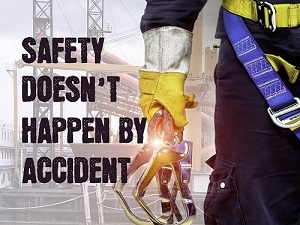Situational awareness is an on-the-job safety skill that is critical for hazard identification, effective decision making, and accident prevention.
Situational Awareness means paying attention and being aware of what’s going on around you. No matter what your role is at work, situational awareness is an important key to keeping everyone safe.
When you practice situational awareness at work, you remain alert and aware of things like:
- where your co-workers are while they are working and what they are doing
- where operational heavy equipment is and how it is moving
- where you are supposed to be
- what sounds you hear
- what potential hazards are nearby
- what you are supposed to be doing
- what are the safe procedures for the tasks you are completing
- what changes are happening that might affect your actions
- what is going on above and behind you
- what unusual smells are in the air
- what do you see that is out of the ordinary
- what is the weather like, if you are working outdoors
Situational awareness involves three elements which are observation, comprehension, and anticipation.
- You observe what is happening around you and take in all the elements of your environment.
- You comprehend the situation you are experiencing.
- You anticipate what is likely to occur next based on what you understand to be happening now.

There are many factors that will reduce situational awareness that workers must be aware of and make an effort to avoid, including:
- Rushing through a task
- Mental or physical fatigue
- Complacency
- Poor communication
- Distractions
- Daydreaming, loss of focus
- Stress
Situational awareness is something that should be happening all the time, throughout the workday. But there may be times when you should increase awareness of your surroundings and your actions, for example, when:
- starting new or non-routine tasks
- working with new co-workers
- visitors are at the work site
- the work environment may have changed
- there is high stress, or a high workload situation
- you have a gut reaction that something may be off
- beginning work on a project, even if you have performed the tasks before
- high hazard operations are taking place (examples: near electrical, at heights, in confined spaces)
Think about some specific examples of what situational awareness may look like on the job...
Not walking into the “line of fire” when other workers nearby are using tools or equipment.
Noticing that a co-worker forgot to put on PPE or missed a safety step and speaking up to ensure they follow the correct procedure.
Stopping a task to make adjustments that will get the job done safe and efficiently.
Correcting hazards on the spot if you notice something that can be fixed immediately.
Reporting hazard observations and near miss incidents to management.

Just looking around from time to time is not enough. At all times you must have an increased awareness of what is going on around you so if conditions change, you can respond quickly, communicate effectively, and avoid the risk of injury or damage.
When things are running smoothly, there may be a relaxed awareness as everyone completes their work tasks safely and efficiently. As situations change throughout the day, some find a simple trick known as the SLAM method to be helpful at promoting situational awareness.
STOP - Think before you act. Consider the task and make sure you understand what needs to be done.
LOOK - Carefully observe the work area to find potential hazards.
ASSESS - Evaluate the hazards and make sure you have the proper tools, training, and PPE to be safe.
MANAGE - Make changes, ask questions, and take the actions you need to continue to work safely.

There are many safety tips workers can practice to increase situational awareness.
Pay attention to what is going on all around you, including above, to the sides, and also behind you and then create a habit of regularly assessing the tasks you are doing and your work environment.
Acknowledge cues you are getting from your co-workers, which may be verbal, emotional, or physical and also observe all warning, danger, and information signs – they are posted for a reason.
Be proactive when it comes to communicating with your supervisor and co-workers. Ask for assistance if you need it, or if it could be helpful.
Understand the pace of the work environment. Watch for unexpected scenarios and adjust accordingly.
Ensure complacency is not creeping into the workday. Avoid using electronic devices including cell phones and headphones. Prevent fatigue by maintaining a consistent sleep schedule.

.jpg)

